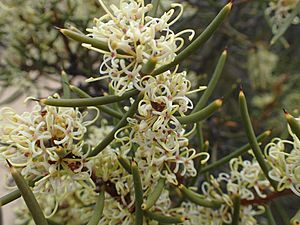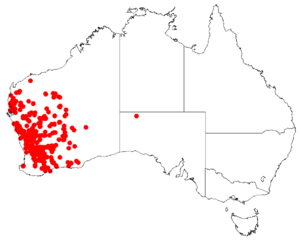Needle tree facts for kids
The Needle Tree (scientific name: Hakea preissii) is a cool plant from Western Australia. People also call it the needle bush or Christmas hakea. It's part of a plant family called Hakea. The Noongar people, who are the traditional owners of the land, call this plant Tanjinn.
Quick facts for kids Needle tree |
|
|---|---|
 |
|
| Hakea preissii growing on the edge of Lake Hurlstone near Hyden | |
| Scientific classification | |
| Genus: |
Hakea
|
| Species: |
preissii
|
 |
|
| Occurrence data from Australasian Virtual Herbarium | |
Contents
What the Needle Tree Looks Like
The Needle Tree can be a shrub (a bushy plant) or a small tree. It usually grows about 2 to 4 meters (6 to 13 feet) tall. Its new branches are a bit fuzzy at first. But they quickly become smooth and have a waxy, bluish-green look in their second year.
The leaves of the Needle Tree are stiff and simple. They are usually 1 to 6 centimeters (0.4 to 2.4 inches) long. They are also quite narrow, about 1.5 to 2.5 millimeters (0.06 to 0.1 inches) wide. Sometimes, a leaf might split into two or three tips.
Flowers and Fruit
The Needle Tree has groups of yellow-green flowers. These flowers grow where the leaves meet the stem. Each group can have anywhere from 4 to 28 flowers. The small stalks holding the flowers are about 3.5 to 7 millimeters (0.14 to 0.28 inches) long.
After the flowers, the tree grows smooth, grey to black fruit. These fruits are shaped like an oval or an egg. They are wider at the top and are about 2 centimeters (0.8 inches) long. They are also about 1 centimeter (0.4 inches) wide. The Needle Tree usually blooms, or flowers, from August to December.
How the Needle Tree Got its Name
The Needle Tree was first officially described by a botanist named Carl Meissner. This happened in 1845. He found a sample of the plant in a forest near York.
The description was published in a book called Plantae Preissianae. The second part of the plant's scientific name, preissii, honors Ludwig Preiss. He was a person who collected many plant samples in Western Australia between 1838 and 1842.
Where the Needle Tree Grows
The Needle Tree is a special plant because it only grows in certain parts of Western Australia. This means it is endemic to that area. You can find it in regions like the Pilbara, Wheatbelt, Mid West, and Goldfields-Esperance.
It is spread out across these areas. You can find it as far north as Tom Price. It also grows as far south as Gnowangerup. The tree is found along the west coast and a bit east of Kalgoorlie.
This plant likes to grow on flat lands and around the edges of salt marshes. It grows well in sandy, loamy, and sandy-clay soils. Sometimes, it can even spread into farmland in dry areas of Western Australia.
Conservation Status
The Western Australian Government's Department of Parks and Wildlife has looked at the Needle Tree. They have decided that this species is "not threatened." This means it is not currently in danger of disappearing.
Images for kids



